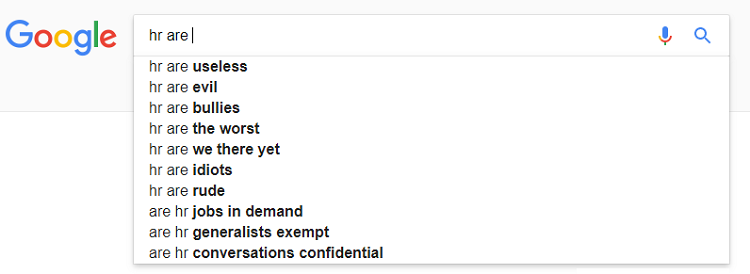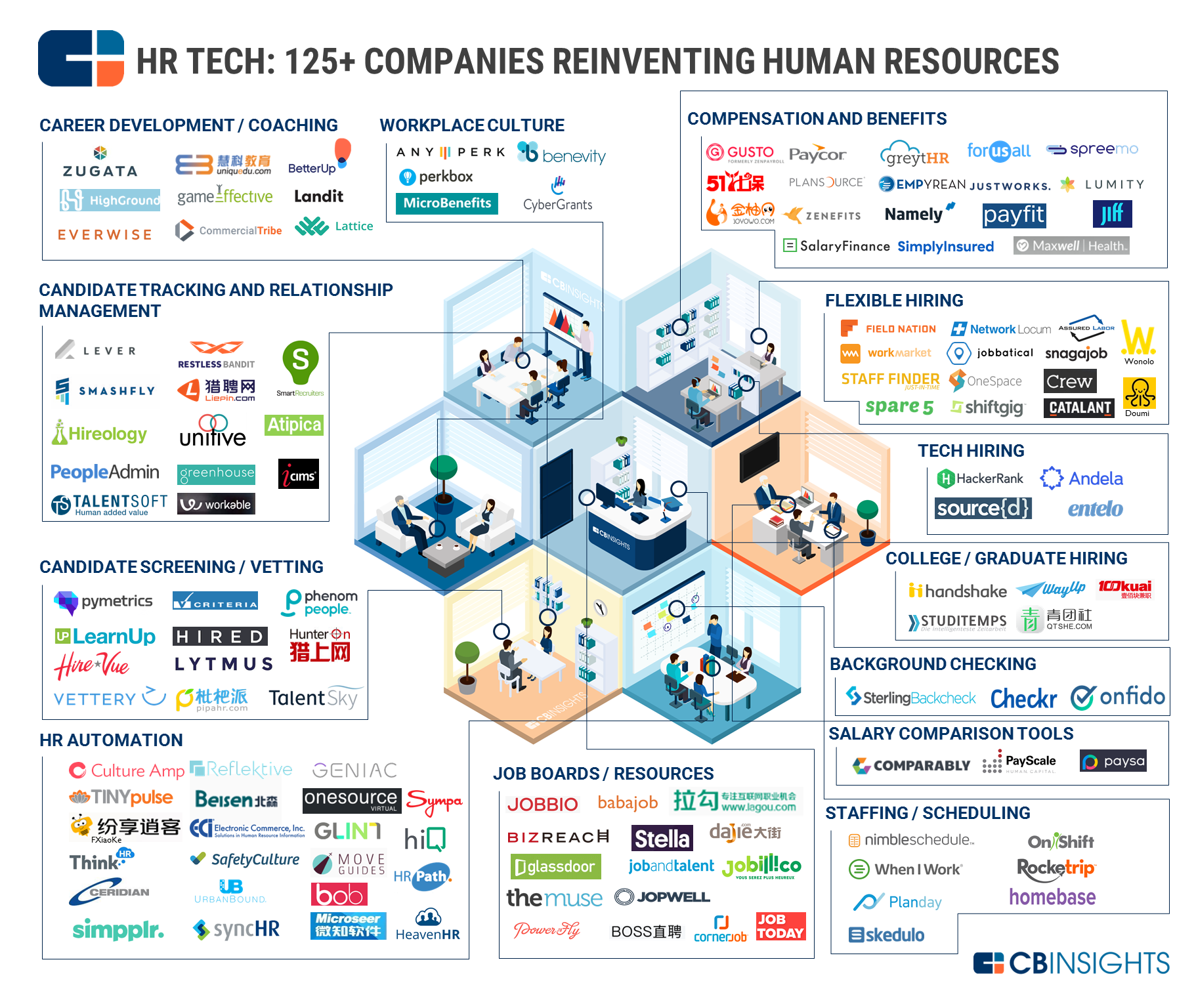Who would argue the importance of HR specialists in our happiness and well-being? There’s hardly a single adult who hasn’t crossed paths with this noble breed of people’s people.
And yet…
Just a simple Google search leaves us wondering if the grass is all that green in the HR field.

Sorry, HR peeps! Not your fault. You’re trying your best.
So what is it then? And how can we, such awesome tech enthusiasts and business visionaries, pay off your sleepless nights? Let’s get to the crux of the matter.

Use the plan below to jump to a question of your interest.
What keeps HR up at night
How overwhelming can it be to ensure business success in this volatile world of distributed teams, emerging technologies, and ever evolving compliance regulations? The survey reveals that the industry concerns fall under these three categories:
HR management concerns
- Employee (esp. millennial) engagement and retention (48%)
- Leadership development and managing skill gaps (45%)
- Best talent recruiting (41%)
HR area concerns
- Recruiting (28%)
- Performance (27%)
- Learning and development (21%)
Technology concerns
- HR systems integration
- The latest tools and technology for efficiency
- HR technology satisfying compliance requirements
- Sound data and analytics for a holistic view of the workforce
Let’s take a closer look at the existing software tools and identify where they fail to deliver value.
HR technology: past, present, and promise

A dash of history
The HR technology landscape is ever-evolving. Back in the early 1970s, when HR was paper-centric, digitizing merely meant making reports printable. The next step was the introduction of ERP systems that provided combined data access via a real-time, mainframe environment.
The launch of PeopleSoft in 1987 was an important milestone. It was the first client-server app specifically designed for HR functions.
The early 1990s saw the advent of HR ERPs (Oracle) that covered reporting, payroll, learning, recruiting, and core HR tasks. But it wasn’t until the late 1990s that web-based HRMS products appeared and cleared the office-computer space.
The year 2000 marked the appearance of best-of-breed solutions that automated specific HR functions, such as recruiting, as opposed to the former one-size-fits-all solutions.
In 2006 much of human resource development software went into the cloud and became more accessible and thus widely adopted.
In 2014 mobile access becomes a standard and gives rise to mobile apps.
In recent years, HR technology has shifted from function automation to user engagement. Gamification has become mainstream in employee engagement and training software. Video interviewing is widely used. And annual reporting has given way to real-time feedback via social networking apps and automated big data insights.
Today’s HR software market
On the face of it, it’s surprising to see the hiring process so painstakingly ineffective in the presence of multiple HR software solutions for all business sizes and sorts. Though it’s true, the existing solutions represent a motley collection where legacy software coexists with cut-of-the edge innovative tools.
Complex solutions
The industry experts cast complex HR tech solutions into three categories – core HR, strategic HR, and workforce management:
- Core HR is a system of record that deals with three major functions – benefits administration, personnel tracking, and payroll management. Once an organization has grown enough to make manual processes burdensome and inefficient, payroll and employee management automating is a regular practice. Companies that create HRIS software provide solutions for large businesses (Oracle, SAP, Workday, Ultimate Software, Infor, Ceridian, ADP) as well as SME (ADP, Paychex, Ceridian, Sage, Gusto, Namely, BambooHR, Zenefits).
- Strategic HR is crucial for attracting and retaining best talent and managing workforce in general. The software of this sort provides a unique blend of applicant tracking and recruiting, performance review, and learning management functionality. Talent management brought to the next quality level by these tools, yields higher employee satisfaction and better retention rates.
- Workforce management systems (WMS) comprise a range of tools to efficiently schedule and monitor the workforce. It specifically suits organizations working shifts to monitor time and attendance, track compliance with labor laws and generally include payroll functionality, or effectively integrate with other payroll software programs.
The key problem with complex HR software development is that it’s highly customized, difficult to use, and expensive to maintain. True, it adds value to process automation. Still, it can’t help secure the best talent, which is a competitive advantage in the knowledge economy of today.
Function-specific tools
Together with creating generalist HRIS software solutions, a lot of companies take a specific HR function to the next level. Here’s how the soft market breaks down as regards HR function automation.
Benefits
It’s hard to attract great talent without worthwhile benefits packages and a great platform to dole them out in customizable plans. The software caters to three functions:
- benefits administration – manage pensions, benefits, and social security accounts (Cobraguard, Penad)
- compensations management – equity plan administration, accounting and reporting (Certent, Kinixsys)
- payroll for small (Xero, Wave), mid-sized, and large businesses (HRPlus, ADP)
Workforce management systems (WMS)
The key focus of any WMS is on the efficient daily operation of the workforce—as aligned with cost and performance objectives. This software category includes the tools for:
- attendance tracking (WhenIWork, Tanda)
- employee engagement – content-rich visual communication solutions (Mvix), sales enhancement tools (Ambition)
- employee scheduling – simplified paper-less, excel-less solutions (TixTime), mobile-optimized (Zip Schedules)
- time & expense tracking (Yanomo, Jibble)
- all-in-one workforce management software (Parim, Blueforce)
Performance management
These tools cater to workplace efficiency. Business management teams constantly seek areas in need of improvement and develop plans for optimizing existing procedures. The software to measure and improve KPIs includes:
- 360-degree feedback (3sixtylite, Impraise)
- employee recognition (Achievers, Peoplecart)
- performance appraisal (Perview, Wethrive)
Training
The software for corporate needs includes platforms and digital learning materials:
Talent management
The key objective of platforms like ViaPeople, HRacuity is to help companies attract and retain some of the best and brightest people in the field or industry by providing measuring tools and consultancy. We can’t help but notice how this area overlaps with performance management and training solutions.
Recruiting
Recruitment software is a package of tools used by recruiters, recruiting teams, or hiring managers during the pre-hire stage of recruiting. The software governs the selection, interviewing, job posting, and candidate feedback. The existing tools fall into two subcategories:
- applicant tracking (OneRecruit, HRboss)
- job board (ZipRecruiter, Workpop)
We can’t help but notice that the software focusing on a specific function takes it to the next level and provides more efficiency, especially in the areas of talent management and engagement. Still, some of the subcategories provide overlapping solutions. HR experts also mention difficulty integrating various tools with the company ERP, FMS, or CRM systems.
Dig deeper into the topic: ‘Recruitment App Development: Digitalization Case Study Overview’.
Areas where HR software development falls short
So why is the existing technology unequal to the demands of modern HR industry? Our research has revealed the following concerns. The digital tools are:
- too many
- not user-friendly or intuitive
- automating the wrong processes
- overlapping in use or incongruent with one another
- lagging behind the growing company needs
- not flexible or forward compatible
- too costly and hard to maintain
Reinventing HR industry: technology and trends
Some incumbent HR software development providers may be cozy and well-placed, reaping the benefits of their honed best-of-breed products. However, HR industry is bubbling with new ideas and yesterday’s novelty can be tomorrow’s disruption. In fact, disruption is already underway brought about by:
- Changing workforce demographics
- The overall technology landscape shift
- Skills shortage due to digital transformation
- Rise of independent workforce/gig economy
Josh Bersin, an HR consulting expert and Principal at Bersin by Deloitte, speaks of these 10 disruptive trends in the HR tech.
#1 New focus on tools for workforce productivity
Improving organizational communication is a way to productivity. We’re facing a global shift away from emails and towards instant messaging systems like Slack, FB Workplace, Skype for Business and collaborative tools like Trello, Jira, Github, etc. These mobile-enabled or cloud-based tools bear some resemblance with social networking platforms – a familiar format for millennials and gen Z. Chatbots inhabit them and humanize automation and collaboration. Real-time communication is crucial in the workplace, but it can also be a game-changer in recruitment: the fastest offer secures the best talent.
#2 ERP and HCM move to the cloud
The core HR shift from purchase to leasing is a great step to address the current behavioral patterns. When getting into human resource development, software engineers go for cloud solutions, which are cheaper upfront, stable, and easy to use, eliminating all the hassle of on-premise software maintenance. Not only do ERP and HCM transit to SaaS, but there’s also a need to integrate both systems as their general function shifts from automation to engagement.
Talent management tools will take up a team-centered design.
Another emerging subcategory likely to grow rapidly is gig- or project-based WMS.
#3 Continuous performance management has arrived
Only 8% of companies believe that their traditional performance management process drives business value. 360-degree feedback is no longer relevant as people move from project to project and team to team. Companies are looking for more adaptable tools. Those include near-term objective setting, regular one-to-ones or ‘check-ins’ and real-time feedback.
New conceptual approach distinguishes the best of these tools, making them engaging, easy-to-use, agile, and data-driven.
#4 Explosion of feedback, pulse survey & analytics tools
According to Josh Bersin, feedback is redefined as a gift to give and receive. It’s indicative of engagement, performance and other metrics any company wants to keep track of. The 5 engagement drivers are meaningful work, hands-on management, positive work environment, growth opportunity, and trust in leadership. But real-time feedback helps measure how well a company implements these best practices. Analytics tools present a holistic picture of a company’s climate and overall performance. New tools like Culture Amp, Talmetrix, TINYpulse, and BetterCompany have different ways of actively measuring employee feedback and sentiment.
#5 Reinvention of corporate learning
Skills acquisition is one of the most pressing issues in today’s job market. The talent shortage is a consequence of sweeping technological change and the rigidity of learning providers. And a new generation of tools (learning experience platforms, program delivery platforms, new LMS), methods (microlearning, gamification, learning communities, learning record score), and content (content libraries, VR & AR solutions) are coming along to bridge this drastic gap.
#6 Candidate-centric and personalized recruiting
Hiring the best fit is something any company aspires to. With a shift towards the global workforce, hiring has become both a blessing and a curse. On the one hand, companies can cast a broader net, on the other, they need better tools and integrations for better reach-out, candidate screening and vetting, applicant interviews, and brand marketing. This is the fastest-growing area of spending. New ways of talent acquisition include video assessment, instant messenger reach-out, cognitive chatbots, big data & digital footprint, predictive analytics, smart screening, etc.
#7 Wellbeing as a new focus in benefit administration
Today’s wellness industry has rapidly shifted its focus from accident and insurance cost reduction to ‘wellbeing’. The HR tech market provides multiple solutions to measure, monitor, and improve wellbeing at work. These include technology platforms, self-assessments, coaching platforms, biometrics, and end-to-end healthcare solutions.
#8 People analytics market growth and maturity
People analytics is now a must-have within HR and business. Three crucial areas of attention are: embedded analytics, AI, and organizational network analysis (ONA).
- Embedded analytics is the fastest-growing area of investment. Companies switch from report generation to ever-ready analysis solutions.
- AI vendors are about to transform data to intelligence. The major providers are currently working to deliver pattern recognition, algorithm refinement, machine learning, and natural language processing.
- ONA technology captures data from emails, feedback activities, and other sources to understand how people are communicating. It identifies workflow patterns, bottlenecks, and roles.
#9 Intelligent self-service, communications and employee experience tools
Self-service platforms allow employees to get questions answered, submit transactions, and find information, without human assistance. These emerging technologies use cognitive, conversational, intelligent systems – IVAs, chatbots, conversational interfaces – to simplify HR transactions.
#10 HR department shift to digital & innovative
The major change is the vector of HR – IT alignment. Tech people used to be way ahead of the HR people innovation-wise. Now the trend has taken a U-turn. Now that HR departments have automated most of their time-consuming functions, they can focus on innovation, which technology enables. HR departments are becoming increasingly tech-savvy. They are looking to create HRIS software solutions that are more team-centric, intelligent, and easy to use.
Clearly, HR digitization has come a long way. Technology has contributed greatly to industry automation, more effective management, and better engagement. A new era of technology will see inefficiencies culled out and a proof of concept for the emerging software. Next-gen tools focus on creating systems of productivity. Let’s recap the HR technology evolution in this mindmap.

Developing recruitment software of the future: the scope and requirements
The biggest talent spending area around the world today is recruiting. While companies spend around $1,200 a year per employee on employee training (making it an approximately $140 billion market), recruiting expenditure is about three times larger. The reason? Over 20% of all workers change jobs every year, so advertising, sourcing, recruiting, interviewing, assessing, and onboarding new talent never ends.
Just a glance at the HR tech startup landscape, and we know it – recruitment transformation is already there. 8 out 13 startup categories focus on taking hiring and onboarding processes to the next level.

Image courtesy of CBInsights
No doubt, recruitment is at the core of business success. And it’s currently an area of major concerns and inefficiencies:
- sourcing and attracting the best fit
- balancing speed and quality
- outdated recruitment strategies
- coping with emergencies (e.g., company growth, emerging skills)
- the war of talent
- competition from startups
Traditional recruitment software focused on two areas – applicant tracking (automatically filtering submissions based on a range of candidate criteria) and job board solutions. Many companies are still stuck with the legacy ATS. But the market needs are much broader and more complex.
Recruitment, as we know it today, has a long roadmap that starts with talent acquisition, building an employment brand, reaching out to universities and talent networks, and creating a network of alumni who speak well about your company. Next comes recruiting candidates into your network, candidate marketing, building talent pools, and communicating with these prospects as they think about changing jobs. The next step is job posting, job advertising, building a compelling career site, and hiring contingent recruiters or gig networks to find people. After that comes strategic and direct sourcing, which typically involves recruiters or smart software systems finding and reaching out to possible candidates, identifying passive candidates, and selling candidates on the company. Finally, once a new employee is hired, the last steps are onboarding and orientation.
So how do today’s innovations fit in with this scheme? These are predominantly peer-to-peer solutions to benefit all the participants of the process in a variety of ways:
- Flexible Hiring. These companies provide a centralized platform for on-demand workers, part-time freelancers or consultants, and part-time jobs. That’s a major shift towards the changing lifestyle. Companies like Field Nation and Staff Finder cater to the employee’s desire for flexible work arrangements in the growing gig economy trend.
- Tech Hiring. Marketplaces like Andela and Entelo offer a centralized platform and tools to screen and match on-demand tech talent for part-time, freelance and full-time jobs.
- College / Graduate Hiring. Career network and recruitment platforms like WayUp provide a platform for job postings and internships that target college students and recent graduates.
- Job Board / Resources. Reinvented peer-to-peer marketplaces like Japan-based job marketplace Bizreach and China-based marketplace Dajie to draw talent to the right job openings globally and effectively.
- Salary Comparison Tools. PayScale, Comparably, and Paysa compare the market salary for positions, compensation, and workplace culture.
New-gen tools for recruiters provide the much needed intelligent search, screening, and vetting.
- Background Checking. Companies like SterlingBackCheck, Onfido, and Checkr offer screening tools to run background checks on potential hires.
- Candidate Screening / Vetting. Companies like Phenom People and Hired provide intelligent recruitment tools that help vet applicants for companies, in advance of an interview (tests, assessments, analytics).
Finally, new complex solutions tailor a smarter overall hiring strategy to suit both parties.
Candidate Tracking and Relationship Management. Applicant tracking system (ATS) software companies Greenhouse Software, iCIMS, and Lever, together with candidate relationship management (CRM) tools, centralize candidate information and provide a platform for companies to collaborate and holistically review applicants.
Together with startups on the market, business giants are also exploring new territory. The launch of Google Cloud Job Discovery in 2017 essentially puts the world’s largest Internet search and advertising company into the talent acquisition market.
Check out how CodeTiburon helped develop A Messaging System to Connect Temporary Worker Companies and the Workforce.
Rethinking recruitment software: feature list
Whatever the complexity of a system, simplicity and ease of use have to be the key metrics in human resource development software. With this in mind, we’ve arranged the features in order of priority into must-, should-, and could-haves, that go from the basic to more advanced functionality. This approach helps the software users to grasp the basics of a product before making decisions on further improvements.

Resume management
Resume pre-screening, the most time-consuming recruitment activity, simply asks for automation. Shortlist the right candidates by automatically parsing resumes and transferring the information to the client/candidate database.
And there’s more. With resume upload, candidates send resumes as attachments on your site. You can automate collecting resumes from attachments, so as not to skip anything. Multi-format resume acceptance allows sending different formats (pdf, rtf, doc, docx). Duplicate detection distinguishes two applicants with identical names. Resume search uses keywords for shortlisting.
Algorithm-fuelled search is the next big thing, for example, Tilr breaks down job titles into skills. Or use an ML algorithm and NLP for smart semantic search, taking account of user intents over keywords. And that’s just the first step. Machine learning algorithms can be used to combine a variety of candidate data such as resumes, social profiles, psychometric assessments, and interviews to analyze how qualified the candidate is for a role.
Applicant tracking
Get another time-consuming recruiting function out of your way to efficiency. ‘Search within candidate profiles’ ensures all profiles and docs are fully searchable. ‘Track applicant status’ means no more need to remember the stages each applicant is in. Someone’s close, but no cigar? Well, keep them on file in case the need pops up (archive). Customize the recruitment workflow to suit your needs. Centralize communication by adding participants. Create a questionnaire. Use NLP for real-time smart screening. For instance, Ideal uses AI for non-conventional data sets — such as video and phone interviews — in order to extract insights on a candidate’s personality, skills and cognitive ability.
Read also: How to Create an Applicant Tracking System and Improve Your Recruitment Process
Collaborative recruiting
Want all relevant participants to engage and contribute to the hiring process? No more bottlenecks just because a chief decision-maker is unavailable. Share notes and evaluations internally, attach documents to candidates, share candidates with team members, assign different stages, create and delegate tasks, set up approval flows (e.g., start recruiting, official job approval, extend offer approval), manage user roles and permissions.
Recruitment automation
Create efficiency by automating routine processes. Auto-archive candidates, create email templates, set up notifications and alerts, replicate recruitment workflow, use email filters to auto-sort the inbox traffic and candidate auto-response to deal with follow-ups. Take care of software integrations should you use any 3-party tools.
Candidate sourcing
When hiring, simply posting open jobs and waiting for applicants is not enough. Promote your openings through different channels so you capture the attention of multiple, qualified candidates. The feature not only provides automatic posting to job boards, professional communities, employee referrals, social media, LinkedIn prospecting, recruiting agencies, and candidate CRM, it also allows simultaneously post in bulk – casting a wider net with a minimum effort. The sourcing dashboard gives you a clear picture of what, where, and when. Narrow down to the metrics that matter to see how your paid placements and social media sharing work.
Reporting
You can’t improve the process unless you can measure it. You will want to share, email, or export data to an excel/pdf file. Source reports feature shows where the applicants are coming from and how far they go into the hiring pipeline. Use EEOC compliance questions for the US-based jobs and safe harbor questions for EU-based jobs. Predictive analytics bind the past, present, and future together and help identify patterns and trends – something impossible to go by in our big-data-driven world. Embedded analytics give you all-time access to the data to make faster and better-informed hiring decisions.
Interviews
Streamline the interview process by connecting all the dots digitally: schedule interviews, integrate with calendar, notify all the participants by email, collect interview feedback, fill in candidate scorecard. Video interviews align with our lifestyle of telecommuting, an absolute necessity for a faster and broader talent reach-out. But there’s more! Experts claim video interviewing has moved beyond screening to appraise presentation skills, learning agility, financial problem-solving, and innovative thinking.
Classified hiring information
Discretion is what builds trust. Filling in private fields will make a candidate’s answers visible only to chosen people. You may also limit access to candidate profiles, have private conversations, or post private openings.
Candidate messaging
Integrate a multi-channel messenger into your recruitment software for a faster candidate reach-out. Create/edit/copy/paste/send messages and attachments to networking sites, IM apps, etc. Make audio calls, pick channels of your choice. Create an IM mobile app or get a chatbot to further qualify candidates, reach passive candidates, and overall improve the candidate experience by being there for them 24/7.
Check the recruitment solution we helped to develop: Recruitment Management System: Lightweight Web and Mobile Solutions with Messaging
Hiring people is by far the most important thing companies do. No amount of HR or management can fix the problem of hiring the “wrong” people. Have an idea of how to take the hiring process to the next quality level? Make it better with us.
To conclude
Global trends of telecommuting, gig economy, employee experience, real-time learning are redefining the workplace and the way companies seek and secure talent. Faster, more comprehensive reachout, better sourcing and candidate vetting tools, more attractive career pages and adverts, more engaging and efficient hiring and onboarding funnel, a digital roadmap for recruiters, collaborative tools for all decision-makers are worth investing in to take the hiring process to a new quality level.
How much does it cost to build recruitment software with CodeTiburon?


Very clear and helpful article. I am already using Great HR Software and these insights helped me a lot to improve my strategies towards employee management. Thanks
Thank you for your comment, Sheetal! Happy to help.
Thanks for this great share. This site is a fantastic resource. Keep up the great work! Many thanks.